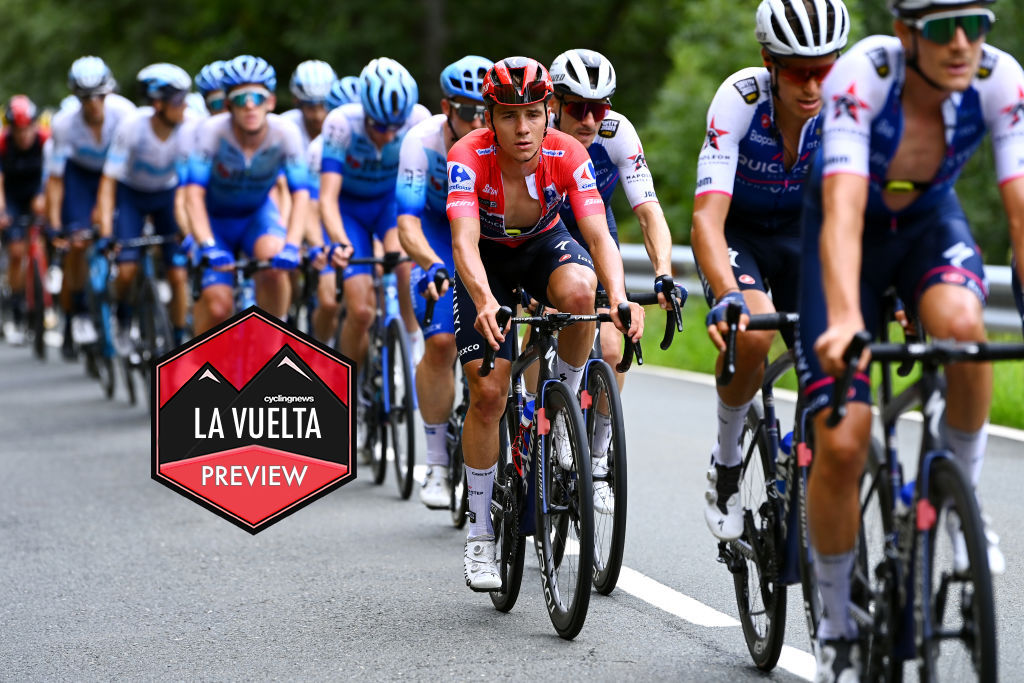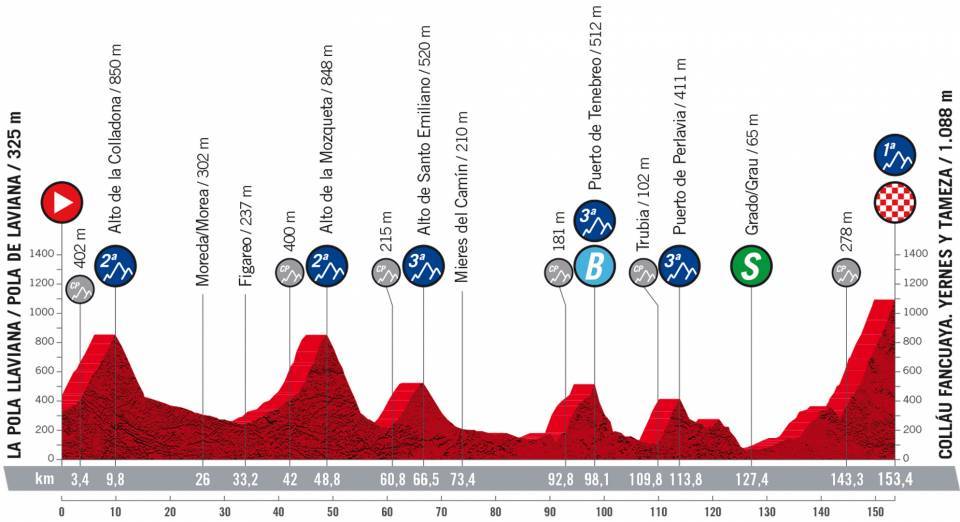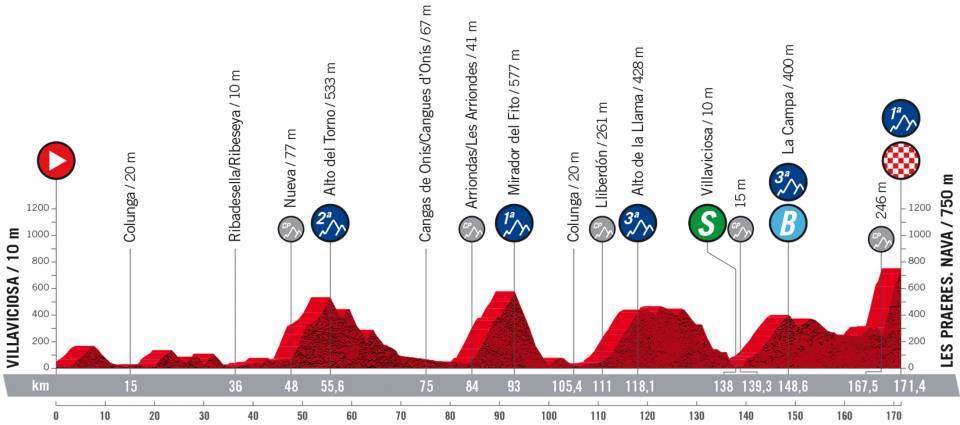Vuelta a España's mountainous weekend double-whammy set to test Evenepoel
GC contenders face summit finishes on stage 8 and stage 9 in Asturias

Barely 48 hours after he took the overall lead of the Vuelta a España, Remco Evenepoel (QuickStep-AlphaVinyl) faces two very different types of climbing tests as the race heads into the mountains of Asturias for back-to-back first category summit finishes at Collau Fancuaya and Les Praeres.
Both days contain more than 3,00 metres of vertical climbing in northern Spain, the first in the sierras of western Asturias, also home to climbs like the Angliru and Gaimoniteiru, and the second further east, in the better-known Picos de Europa mountain range.
According to the latest weather forecast, a deluge on the scale of Thursday’s downpour that accompanied Evenepoel and the peloton as they squelched their way up the Pico Jano is thankfully not likely. But even with drier conditions, as a way to round off the first week, the 2022 Vuelta route designers have opted for anything but a gentle warm down.
While Pico Jano was used in the Vuelta a Besaya junior bike race before making its debut in the Spanish Grand Tour, the Collau Fancuaya has never been used before in a race, amateur or professional.
But while the Fancuaya’s 10.1-kilometre slopes, averaging 8.5%, represent a ‘classic’ mountain challenge, Les Praeres is a ‘side of a house’ climb of the kind the Vuelta organisers have decided to make a trademark ascent in recent years.
“Don’t forget that Les Praeres was where Simon Yates won in 2018 and then he went on to win the Vuelta overall that year. So it’s clearly a finish which can tell us a lot about the different GC contenders, even if it’s only four kilometres long,” 1988 Tour de France winner and long-standing TV cycling commentator Pedro Delgado, who regularly checks out all the summit finishes of the Vuelta before the race, told Cyclingnews.
“It’s very short and very tough, and although there are quite a few climbs earlier on the stage, really the finish is so hard it’s all that will count. And even if it's less difficult, it’s a similar story with the Fancuaya stage.”
The latest race content, interviews, features, reviews and expert buying guides, direct to your inbox!
While stage 8 starts with a second category ascent, the Alto de la Colladona, the 70 kilometres before the Fancuaya itself contains only three third category climbs, all a long way from the finish. As such, the final ascent will almost certainly be where the entire stage is decided.
“The Collau Fancuaya is a very different kind of climb to Les Praeres, much more of a normal first category ascent and much longer,” Delgado said. “The last seven kilometres are what count and although you’ve got some brief points where the slopes ease notably, there’s a couple of long ramps that go up to 16 or maybe 18% as well.
“It’s not overly exposed to the wind apart from the last kilometer, which is a very steady 10%. Coming after what’s come before, that last part may prove so demanding it could do some real damage.
“I didn’t know it at all before going up it a few months back, but when I saw it, I liked it a lot. Asturias has got so many mythical climbs: Lagos de Covadonga, Gaimoniteiru, Angliru and the rest. Collau Fancuaya is maybe not as hard as those but it’s up in their league for sure.”
Both Saturday and Sunday’s final climbs are in good condition tarmac-wise, Delgado said, “although the Praeres is maybe in a bit better condition”. In both cases the approach road constitute a more important challenge.
“On stage 8, the 10 kilometres that precede the Fancuaya are narrow, twisting and very technical. The road surface isn’t great, there are some bad corners and even if it doesn’t rain, it will be dangerous.”
Delgado added that given the easier first part of the stage the teams will mostly still be together and will start working flat out with all of them trying to be on the front, which could create a problem.
"As there’s not going to be space for all of them on such narrow roads, there could easily be a crash.”


Stage 9 is slightly longer than stage 8, totaling 173 kilometres, and its hardest challenge prior to Les Praeres will be the first category Fito, often used as a warmup climb for the Lagos de Covadonga, at roughly the halfway point. But despite the four classified climbs that precede Les Praeres, Delgado predicts that again, the approach road to the finish could become the most fraught moment prior to the final ascent itself.
“The real problem, again, is the approach road, which is essentially a kilometre long descent, fast and very narrow so quite dangerous,“ Delgado said.
“There are no two ways about it, you have to be in front. In many ways, it’s similar to the descent to Hazallanas, the first part of the Sierra Nevada climb where the Vuelta goes next week, which is also narrow and fast.
“But the descent to Les Praeres isn’t just longer, at Hazallanas you’ve got 20 kilometres of climbing afterwards to get to the top. Here you’ve only 3.5 to the summit. So the fight for positioning beforehand will be really intense and on top of that, there could be a crash.
“As it’s such a short climb, unlike the Fancuaya if you're badly positioned you won’t be able to rely on your teammates to pull you back into contention. On Les Praeres, it’s every man for himself.”
As if the approach to Les Praeres and its horrendously steep slopes don't already constitute a major challenge, the climb has a significant sting in its tail, Delgado warns.
“The last 1.5 kilometres of Praeres isn't tarmac, it’s got a cement surface. As if that wasn't bad enough, the last ramp of the climb is the hardest one of all [peaking out at around 24%] and it is only 500 metres from the finish. So if you haven’t calculated your strength well enough, that could be devastating.”
Predicting what will happen on such tough terrain is always risky, but Evenepoel, for one, has said he’ll play a defensive game in Asturias. However, for the 19 riders still at three minutes or less behind him overall and therefore still in clear GC contention, the rapidly approaching time trial next Tuesday and Evenepoel’s immense talent against the clock will likely be uppermost in their minds. And should they wish to put the new race leader to the test, at Collado Fancuaya and Les Praeres, the terrain is certainly challenging and varied enough to at least have a try.
Alasdair Fotheringham has been reporting on cycling since 1991. He has covered every Tour de France since 1992 bar one, as well as numerous other bike races of all shapes and sizes, ranging from the Olympic Games in 2008 to the now sadly defunct Subida a Urkiola hill climb in Spain. As well as working for Cyclingnews, he has also written for The Independent, The Guardian, ProCycling, The Express and Reuters.
